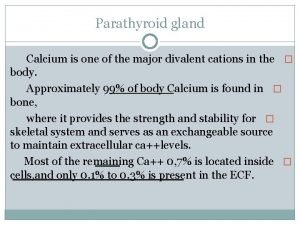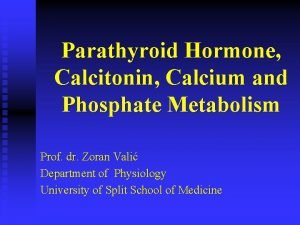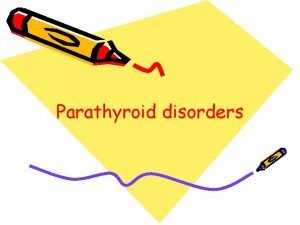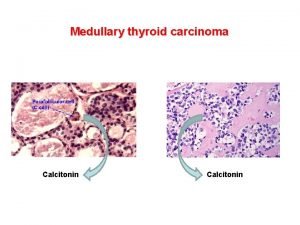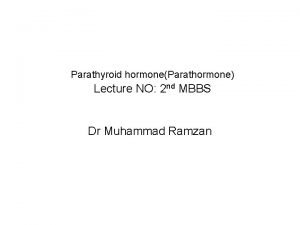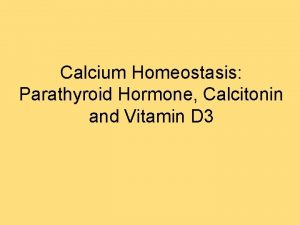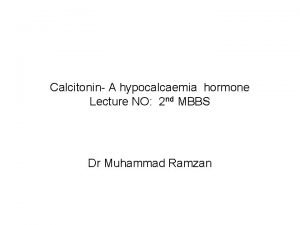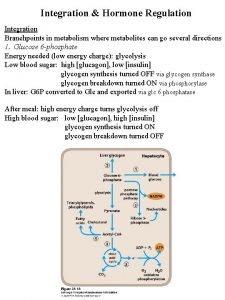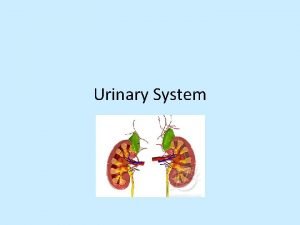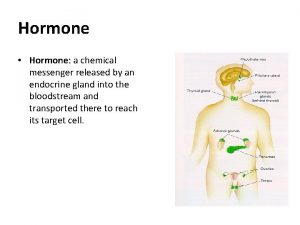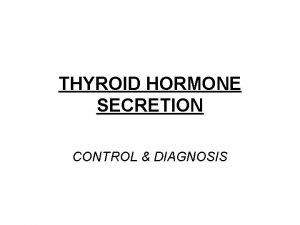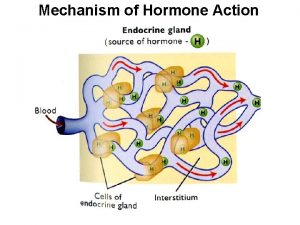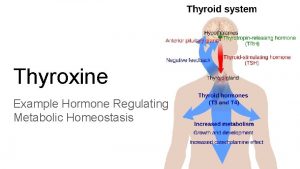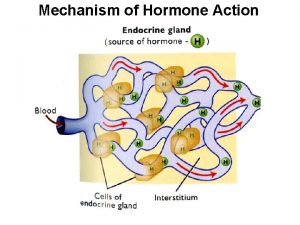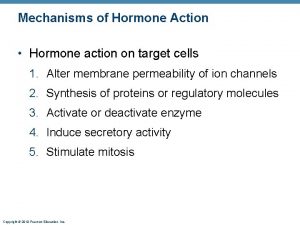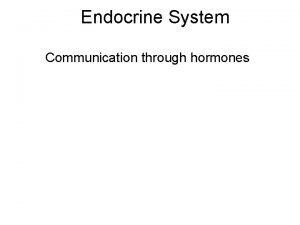Calcitonin A hypocalcaemia hormone Lecture NO 2 nd























- Slides: 23

Calcitonin- A hypocalcaemia hormone Lecture NO: 2 nd MBBS Dr Muhammad Ramzan

Calcitonin – the definition • Calcitonin is the formal name of a protein hormone secreted by the Para follicular cells of Thyroid gland • Also called Thyrocalcitonin • Major action of the Calcitonin is to inhibit the bone resorption by the Osteoclasts.

Calcitonin – the background ↓ Ca++ level when it is high • Calcitonin reduces serum Ca++ and PO 4 level when it is high, opposite to the action of PTH • This action of Calcitonin is through Osteoblasts and Osteocytes that have Calcitonin receptors. • Osteoclasts do not have Calcitonin receptors and so is true about the PTH receptors

Calcitonin – Synthesis 32 AAs • Calcitonin is a single chain peptide of 32 AAs • Calcitonin is synthesized as a Prohormone having 115/142 AAs by the RER of : • Para follicular cells • It is cleaved to have 42/37/32 Amino acids after passing through Golgi Complex

Calcitonin – Synthesis cont. stored a vesicles • It is stored as secretary granules in the cytoplasm of the Para follicular cells • It Is released in response to an appropriate stimulus like high serum calcium level • Calcitonin has its own GPCR on the plasma membrane of the target organs

Calcitonin - structure

Calcitonin – Target tissues bone cells, renal tubules and GIT • Target tissues are the ones with Calcitonin receptors • The target organs for the Calcitonin are the : • Osteoblasts; Osteocytes, Renal tubular cells and GIT • Target tissues also bear PTH receptors and are also involved in binding Calcitonin • There are no Calcitonin receptors on Osteoclasts

Calcitonin – the target organs

Calcitonin - Regulation of secretion serum and ECF Ca++ • It is through negative feed back like PTH • Serum and extracellular calcium level is the major regulator of Calcitonin secretion • Serum Po 4 does not play an active role in human • There are 2 pathways for the regulation of Calcitonin • 1. Direct and 2. Indirect

Calcitonin – Direct regulation interaction B/W Ca and Calcitonin • It is the interaction B/W serum Ca++ level and the Calcitonin • High Ca level stimulates Para follicular cells to ↑ synthesis of Calcitonin that lowers serum Ca++ level • It will also inhibit the Osteoclastic activity but promotes bone formation ( deposition of Ca) • There is no role of PTH

Calcitonin- Direct regulation

Calcitonin – Indirect regulation via PTH • Low serum Ca++, stimulates the Para thyroids to ↑ PTH secretion and Osteoclastic activity • This elevates serum Ca++ and inhibits Calcitonin synthesis by inhibiting Para follicular cells • Normal Ca level is 9 - 11 mg/100 ml

Indirect regulation of Calcitonin

Calcitonin - Mechanism of action GPRC • Calcitonin is a peptide and its mechanism of action is like other peptides/proteins – 2 nd messenger • Calcitonin binds to the extra cellular domain of GPCR on Osteoblasts, Osteocytes and Renal tubules • Produces conformation changes in membranous subunit

Calcitonin – Mechanism of action cont. • It leads to the activation of G protein and binding of its α-subunit to the GDP in exchange for GTP • Membranous Adenylate Cyclase is stimulated by α-GTP and converts ATP to c. AMP – the 2 nd messenger • c. AMP activates Protein Kinase that Phosphorylates other proteins/enzymes to execute hormonal actions

Mechanism of Action – 2 nd messenger GPCR

Metabolic role of Calcitonin • Depends upon its action on target organs • These include : • Bones • Kidneys • and Intestines

Calcitonin – the metabolic role

Effects on bone activity • Calc. inhibits Osteoclastic activity and bone resorption • Less Ca and PO 4 are mobilized from the bone to blood • Lowers serum and extracellular calcium ions • Calcitonin promotes Osteogenesis and Osteoblastic activity especially in children

Effects on Kidneys • It inhibits resorption of Ca and Po 4 from the distal tubule and ascending loop of Henley 1 • It promotes the renal excretion of Ca and PO 4 to reduce the blood calcium level 2 • Calcitonin inhibits the activation of Vitamin D in kidneys

Effects on intestine • Reduction in the activation of Vitamin D that reduces absorption of calcium from GIT • It lowers the blood calcium level

Calcitonin – Secretion abnormalities • A large no of diseases are associated with abnormally excess or deficiency of Calcitonin • However, the pathologic effects of abnormal Calcitonin secretion per se are not generally recognized.

Clinical significance of Calcitonin • Para follicular cells involved in thyroid malignancies • This results in ↑ Calcitonin with no significant hypocalcaemia • It is used for the treatment of osteoporosis after menopause and hysterectomy. • Further it is also used in the hypocalcaemia due to malignancies, hyperparathyroidism and VIT. D intoxication
 Parathyroid gland image
Parathyroid gland image 01:640:244 lecture notes - lecture 15: plat, idah, farad
01:640:244 lecture notes - lecture 15: plat, idah, farad Bone fluid
Bone fluid Calcitonin (salmon) coupon
Calcitonin (salmon) coupon Skull fracture types
Skull fracture types Trosseau sign
Trosseau sign Medullary thyroid cancer
Medullary thyroid cancer Pth hormone
Pth hormone Chapter 45 hormones and the endocrine system
Chapter 45 hormones and the endocrine system Calcitonin vitamin d
Calcitonin vitamin d Osteopern
Osteopern Calcitonin
Calcitonin 分泌降鈣素( calcitonin )的細胞為何 *
分泌降鈣素( calcitonin )的細胞為何 * Calcitonin function
Calcitonin function Steroid hormones lipids
Steroid hormones lipids Benjamin cummings
Benjamin cummings Gigantism vs acromegaly
Gigantism vs acromegaly Libido
Libido Hormone organ
Hormone organ Acth
Acth Horm res paediatr
Horm res paediatr Sex hormone
Sex hormone Blood to urine pathway
Blood to urine pathway Hormone
Hormone
